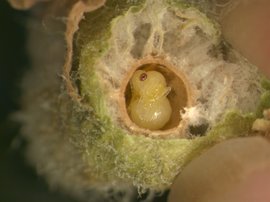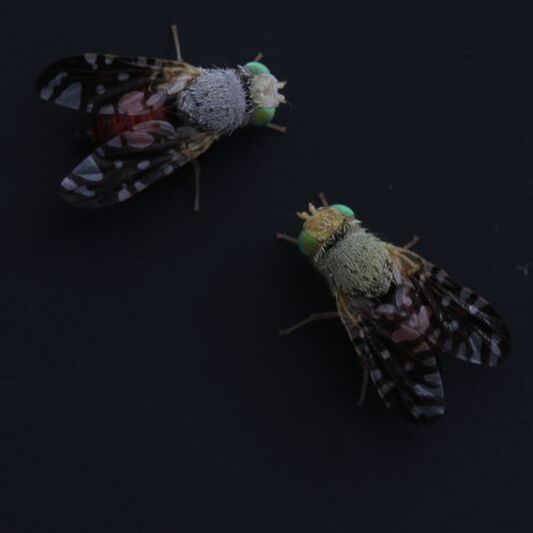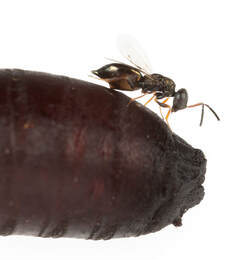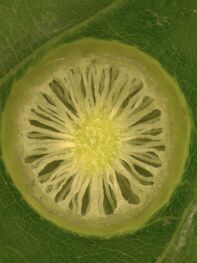Molecular mechanisms of species interactions
Every organism on earth depends on interactions with other organisms to survive. These symbiotic interactions exist on a continuum from mutualistic to parasitic. In each of these interactions, an organism must use their own limited toolbox of genes, proteins, and pathways to successfully manipulate or cooperate with another species. Novel interactions often necessitate the creative use of existing pathways or the acquisition of new resources, especially in interactions between distantly related species. My research is driven by the question – How do organisms repurpose existing genes/pathways or acquire new tools to facilitate species interactions? I work in animal-animal and plant-animal interactions ranging from mutualisms to antagonisms.
To address my main research question, I use genomics, transcriptomics, proteomics, and metabolomics to identify potential molecular mechanisms behind interactions in stable symbioses by identifying which genes/proteins/pathways are at the core of the interaction. These are then evaluated with functional genomics and placed into phylogenetic context, which allows me to determine how genes and pathways have evolved after being recruited to a new role. I am especially interested in interactions centered around ecological shifts in host usage, such as expanding or contracting host ranges or novel host adaptations (e.g. galling, ecto- to endo-parasitoid, blood to nectar feeding). These shifts have independently occurred multiple times throughout the tree of life and by placing them in an evolutionary context, the mechanisms behind these drastic changes and novel adaptions can be identified at the genetic level.
Every organism on earth depends on interactions with other organisms to survive. These symbiotic interactions exist on a continuum from mutualistic to parasitic. In each of these interactions, an organism must use their own limited toolbox of genes, proteins, and pathways to successfully manipulate or cooperate with another species. Novel interactions often necessitate the creative use of existing pathways or the acquisition of new resources, especially in interactions between distantly related species. My research is driven by the question – How do organisms repurpose existing genes/pathways or acquire new tools to facilitate species interactions? I work in animal-animal and plant-animal interactions ranging from mutualisms to antagonisms.
To address my main research question, I use genomics, transcriptomics, proteomics, and metabolomics to identify potential molecular mechanisms behind interactions in stable symbioses by identifying which genes/proteins/pathways are at the core of the interaction. These are then evaluated with functional genomics and placed into phylogenetic context, which allows me to determine how genes and pathways have evolved after being recruited to a new role. I am especially interested in interactions centered around ecological shifts in host usage, such as expanding or contracting host ranges or novel host adaptations (e.g. galling, ecto- to endo-parasitoid, blood to nectar feeding). These shifts have independently occurred multiple times throughout the tree of life and by placing them in an evolutionary context, the mechanisms behind these drastic changes and novel adaptions can be identified at the genetic level.
Venom evolution in parasitoid wasps
I focused on the evolution of venom in parasitoid wasps. Parasitoid wasps are diverse and ecologically important insects that use venom to modify their host’s metabolism for the development of their offspring. Such modifications include developmental arrest, selective cell apoptosis, and immune suppression. The model parasitoid wasp Nasonia vitripennis has approximately 100 venom proteins, nearly a quarter of which do not have sequence similarity to any other known proteins. Using genomes, transcriptomes, proteomes and metabolomes, we are investigating the effects of the venom of N. vitripennis and their close relatives on their host flies. So far we identified previously unknown effects of venom such as the up-regulation of antimicrobial pathways, discovered a lateral gene transfer that has become a functional venom component, and proposed mechanisms that underlie known effects. We are currently determining the function of individual venom proteins through unique phylogenetic frameworks and RNAi knockdowns.
I focused on the evolution of venom in parasitoid wasps. Parasitoid wasps are diverse and ecologically important insects that use venom to modify their host’s metabolism for the development of their offspring. Such modifications include developmental arrest, selective cell apoptosis, and immune suppression. The model parasitoid wasp Nasonia vitripennis has approximately 100 venom proteins, nearly a quarter of which do not have sequence similarity to any other known proteins. Using genomes, transcriptomes, proteomes and metabolomes, we are investigating the effects of the venom of N. vitripennis and their close relatives on their host flies. So far we identified previously unknown effects of venom such as the up-regulation of antimicrobial pathways, discovered a lateral gene transfer that has become a functional venom component, and proposed mechanisms that underlie known effects. We are currently determining the function of individual venom proteins through unique phylogenetic frameworks and RNAi knockdowns.

Insect-induced galls
Plant galls formed by insects are among the most bizarre structures produced by interspecific interactions and range from simple tissue swellings to complex structures displaying pigments and defenses novel to the host plant. Insect-induced galls are an extended phenotype where the initiation, development, and maintenance of galls is controlled by the insect, but the gall is composed of plant tissue. Gall induction has evolved independently in six insect orders and has been described for >13,000 insect species. The question of how an organism can manipulate the growth and structure of another organism from a different kingdom of life dates back to scholarly writings in ancient Greece and China. I am interest in understanding how these manipulative interactions evolved, the genes or gene products involved, and whether the regulatory mechanism(s) behind gall induction and development is consistent across independent insect lineages that form galls. Recent advancements in sequencing technologies and assembly algorithms have made employing genome-wide studies of non-model organisms possible in experimental evolutionary studies, therefore we are now poised to uncover the molecular ecology of this complex interspecies relationship. We are currently working with several galling systems including cynipid wasps on live oaks, chalcid wasps on blueberries, and tephritid flies on rabbitbrush.
Plant galls formed by insects are among the most bizarre structures produced by interspecific interactions and range from simple tissue swellings to complex structures displaying pigments and defenses novel to the host plant. Insect-induced galls are an extended phenotype where the initiation, development, and maintenance of galls is controlled by the insect, but the gall is composed of plant tissue. Gall induction has evolved independently in six insect orders and has been described for >13,000 insect species. The question of how an organism can manipulate the growth and structure of another organism from a different kingdom of life dates back to scholarly writings in ancient Greece and China. I am interest in understanding how these manipulative interactions evolved, the genes or gene products involved, and whether the regulatory mechanism(s) behind gall induction and development is consistent across independent insect lineages that form galls. Recent advancements in sequencing technologies and assembly algorithms have made employing genome-wide studies of non-model organisms possible in experimental evolutionary studies, therefore we are now poised to uncover the molecular ecology of this complex interspecies relationship. We are currently working with several galling systems including cynipid wasps on live oaks, chalcid wasps on blueberries, and tephritid flies on rabbitbrush.



